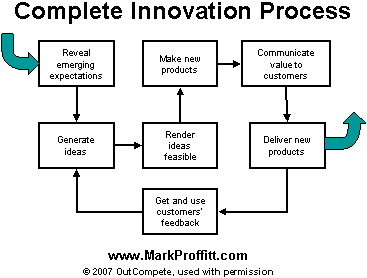Why do 88% of Ideas Fail to Make it to Market?
The reason 88% of ideas fail to make it to market is companies have no system to turn ideas into marketable innovations.
Even though 87% of CEOs list innovation as a Top 5 priority 78% of companies have NO INNOVATION SYSTEM.

Do you think it’s a coincidence that 88% of ideas fail to make it to market when 78% of companies lack any innovation system?
Innovations produce 300% larger return on investment than capital investments. You can clearly see why CEO’s list innovation as a top priority. Innovation is the best source of profits.
Why don’t more companies have an innovation system?
Innovation is wrongly linked to creativity. That is the main reason companies don’t have an innovation system. CEO’s instinctively know creativity doesn’t lead to profits. There’s a reason for the phrase “starving artist.”
Creativity is unpredictable and unmanageable. Almost all systems marketed to increase innovation focus on increasing creativity. Increasing creativity might help generate ideas, but does it generate marketable ideas you can produce?
Creativity is a bad source of innovative ideas. Being different, new, or “outside the box” doesn’t equal a successful product. Successful products satisfy customers’ desires. Satisfying customers’ desires is the best definition of innovation.
To successfully satisfy customers’ desires you must:
“Deliver to the right customer exactly what the customer wants, exactly where and when the customer wants in exactly the way and for exactly the amount the customer is willing to pay.”
There is such a thing as a bad idea. Any idea that doesn’t satisfy a customer’s desire is bad.
But even great ideas need help to make it to market. A complete innovation system generates good ideas and profitably brings the ideas to market. There are two main goals of innovation.
Create good ideas and profitably bring them to market.
Systems that achieve both goals amplify success. And if either one is missing there is no innovation.

Studies show that adding any development system at all doubles the number of ideas that make it to market. But even doubling the number of ideas that make it to market still is terrible results.

Companies with no development system need 8.5 ideas just to get one to market. Companies with a system need 3.5 ideas to get one to market. But that is still only 29% success.
Would you buy a telephone that dialed a wrong number 2 out of 3 times? How about a car that left you stranded 5 days per week? Of course not! You don’t want any old system.
You want a complete system that works.

Generating good ideas and profitably bringing good ideas to market requires 7-steps.
Successful innovation requires success at all 7-steps. Generating ideas is only one of the 7-steps. Creativity only helps with generating ideas. So the creativity approach stops after one step leaving 86% of the important work completely ignored.
A truly successful innovation system must do more than just do the 7-steps. A truly successful innovation system must do all the 7-steps well.
A successful innovation system must satisfy 7-qualities for every one of the 7-steps.
The successful innovation system must be:
- Efficient
- Low-Risk
- Controllable
- Repeatable
- Competitive
- Reliable
- Just-In-Time
Combining the 7-steps with the 7- qualities and the requirements of “giving all participants compelling reasons to use the system†plus “matching the companies other processes and approaches†you have 51 Criteria for a Complete Innovation System.
Contact me for a FREE copy of “What Makes an Innovation System Complete.”




 Predictive Innovation Training
Predictive Innovation Training Predictive Innovation: Core Skills Book
Predictive Innovation: Core Skills Book RoundSquareTriangle.com
RoundSquareTriangle.com
Great article, Mark.
It reminds me of a couple of good books, “The Innovator’s Delemma” and “Serious Creativity”
Lots of companies would do better if they simply started applying some of the principles you lay out. There’s a huge difference between creativity and innovation, and a huge difference between innovation and disruptive innovation. Those are all terms each business manager must understand at a gut level.
Interesting article, Mark.
What is the source for your statistic ‘88% of ideas fail to make it to market’?
Jullian, That number comes from a variety of sources. It also depends on what you call “an idea”. If you start from raw idea it takes 3000 ideas to get one success, or 96.7% failure. If you look at products that are launched, the failure rate is 40%. I got that 88% number from looking at several sources and comparing ideas that received some level of work, not just raw ideas. One of the sources I used was this.
Stevens, Greg and Burley, James (1997), “3,00 Raw Ideas = 1 Commercial Success”, Research Technology
Management, 40(3), May-June 1997, 16-27.